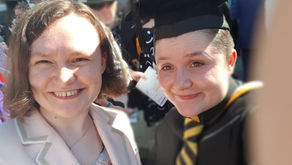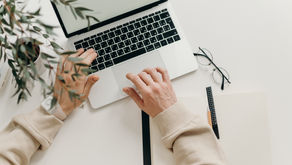Week 1: Studio Culture
- Tramaine Berry
- Sep 20, 2020
- 6 min read
Updated: Sep 21, 2023
Hello everyone! It's the first week of my two-year masters degree, and I am really excited to get started!
RESEARCH //


After looking through all the case studies from the lecture, one thing most designers have said is that they get inspired by more than the design world like literature, films, art, etc. because that is where all the weird and original ideas come from. During my BA degree, I found that I didn't pay attention to the design world as much as my tutors would have liked me too, which in hindsight did affect the quality of my designs; however, my idea generation was my strong suit because I spent most of my time daydreaming and getting my ideas from other sources. If the idea is bad, it doesn't matter how good the design is.

This week's case studies have shown me that freelancing and remote studios such as Non-Format are trending. This is a relief to me because all the studios and clients are based in London, which isn't where I see myself in the future; there's nothing like a small and vibrant community to influence creativity and a healthy mindset. Although, being completely remote means that you need to make up for the fact that you don't have much studio culture, so it helps to be in a beautiful town like Falmouth.
Non-Format studio is a remote studio run by Kjell Ekhorn and Jon Forss, located in the USA and Norway. They are best known for their expressive imagery and custom typography. I am particularly interested in the visual language for 2018 Only Connect Festival of Sound due to its simplicity and use of layering; it feels dynamic and has a sense of playfulness. I also think the greyscale photography makes the brand look like it is bringing life to those photographs, as if to say they are the life of the party and will bring vibrance to your day.

I am glad I am in an age where I am able to work from my laptop because it is less expensive to produce work; I don't need to rent out a studio, buy equipment or move to a hotspot to find local clients, although it does dawn on me that more is expected from designers for a lower budget. When you are looking for new clients, you have to compete with international designers that charge next to nothing. And when you are looking for an in-house job, you are expected to have multiple specialisms, which is why according to my case studies, studios are now hiring freelancers to save money. I'm not completely against freelancing, in fact, I can see myself doing it in the future because you have the opportunity to move from client to client, getting a wider range of projects. However, like Spiekerman points out, people are one of the three important elements within studio culture, my trip to Edenspeikerman a couple of years ago was very friendly and almost a family-like atmosphere and it makes me wonder whether the lack of permanent staff in studios decreases the vibrant atmosphere that most studios are famous for.
He also mentions that even in a remote studio, it is always important to maintain a sense of humour because it ...
Boosts focus and improves memory
Improves decision-making and divergent thinking
Allows you to connect socially with others and builds trust
Increases productivity
Edenspiekerman is an independent design consultancy based in Berlin, Amsterdam, Los Angeles, Singapore, San Francisco and Chicago. Erik Speikerman has founded this studio along with MetaDesign and FontShop.

'Studios that get the balance right between remuneration and the right sort of work are the ones that prosper'.
I can agree with Erik Speikerman's statement. The amount of unpaid internships I've seen during this pandemic is shocking. Even though it gives you experience and might seem like a cool project to do, I think it undervalues the designer's work and is insensitive to the fact that a designer needs to pay for rent and food. At the same time, a large income doesn't make a designer more creative when they are doing a project that they find uninspiring. Erik Spiekerman does touch on an interesting point about how sometimes we as designers end up working for the commercial world, no matter how strong your beliefs are about 'common good' because that is the world we are in. Unfortunately, I have found this is partly true, especially now when there are so many other people looking for work. Although giving in to any design job does ruin the balance between money and an inspiring project that fuels creative passion, I have found that one way to work around this is to widen our definition of 'social design' because there is no guarantee that we as designers will get regular work that way. As long as I work for someone that doesn't sell something unhealthy to the mind and body, I am creatively motivated to work for them.
WORKSHOP CHALLENGE //
Who
This is a logo that I designed for myself. It started off as a campaign logo for Student Welfare President, which I decided to develop because it reminds me of the type of work I want to do; I love helping people and coming up with solutions that will improve someone's wellbeing.
What
I am a recent graduate and looking for work. Since its unlikely that many people will be visiting family's for Christmas, I've been developing a Christmas cracker that is designed to fit in a letter box, and you can open it yourself. It's a way for families to send a smile no matter where you are.
Where
I originally came from Weston-Super-Mare and moved to Falmouth for my BA degree. Falmouth made me feel so welcome! It was like a friendlier version of home! I cannot begin to describe how much the university has helped me grow as a person; I certainly would have never thought that I would have the confidence to become an ambassador, student mentor and jump off a plane.
Why
The concept of earning an income a smile at a time is very humbling. I love figuring out how to improve someone's wellbeing.




FEEDBACK //
Your responses to the Week 1 brief is an evidence of creative thinking, however the outcome is basically text + image combination. Perhaps it is worth to think how one could work without another?
Colour scheme is very strong, I think the original Falmouth panel was better without the plane maybe – it was cleaner. Love the mailable Christmas cracker!
Kept a good and consistent colour scheme throughout.
Great colour pallet
I thought that the strawberry idea was a very creative way of playing with your name and it was nice that you kept the theme consistent with the core colours of a strawberry. Perhaps you could have incorporated more personal aspects that answer the who, what, where and why, in more detail to make it a little bit more personal.
Nice logo, I like how the berry is used but looks a little like a chilli to me.
Like the colour scheme and use of tones across all four images. There is also a sense of playfulness that I appreciate – something which isn’t always present in personal branding – it comes across in a more authentic way.

REFLECTION //
Not only was this workshop fun to do, this also allowed me to think deeper about who I am as a designer and how the location has affected my creativity. The ‘where’ was the most challenging because I never considered how moving to Falmouth influenced my level of creativity. The easiest was the ‘why’ and ‘what’ because my third year of Graphic Design BA gave me the time and resources to figure this out. This week has also made me reflect on the backstory of my personal brand, allowing me to confidently say that my brand isn’t only the definition of ‘what’ I do.
Doing my first week as a remote learner has made it easier than my campus based BA course because the ideas wall enables me to receive more feedback from my peers and at a faster pace. Plus, all my peers are from different backgrounds with different levels of experience.
After looking through all the case studies, one thing most designers have said is that they get inspired by more than the design world like literature, films, art, etc. because that is where all the weird and original ideas come from. During my BA degree, I found that I didn’t pay attention to the design world as much as my tutors would have liked me too, which in hindsight did affect the quality of my designs; however, my idea generation was my strong suit because I spent most of my time daydreaming and getting my ideas from other sources. I think I could have looked at designers to inspire my workshop.
REFERENCES //
Shaughnessy, A. and Brook, T. (2009). Studio Culture: The Secret Life of the Graphic Design Studio (Links to an external site.) London: Unit Editions.
SomeOne (Remote Visitation)
Sam Winston (Remote Visitation)
Regular Practice (Remote Visitation)
Sarah Boris (Remote Visitation)
Intro Design (Remote Visitation)
Video by William Read, 'Colour Grade'.
https://www.humorthatworks.com/benefits/30-benefits-of-humor-at-work











Comments